#SLIME MOLDS
Text
hey not to brag or anything but so far this summer I’ve seen 1 slime mold (dog vomit slime mold crawling on a stump along a trail) and 3 horsetail stands (the last one a couple days ago in a dirty ditch behind an office park) and 2 days ago I saw a pair of turkeys with 4 little fluffy baby turkeys between them. just so everyone knows and we’re on the same page here
#slime molds#horsetails#horsetails = equisetum for those not acquainted. i love them#nothing quite like the old ‘big straw’ plant design. one could argue you can’t improve on perfect
2K notes
·
View notes
Text
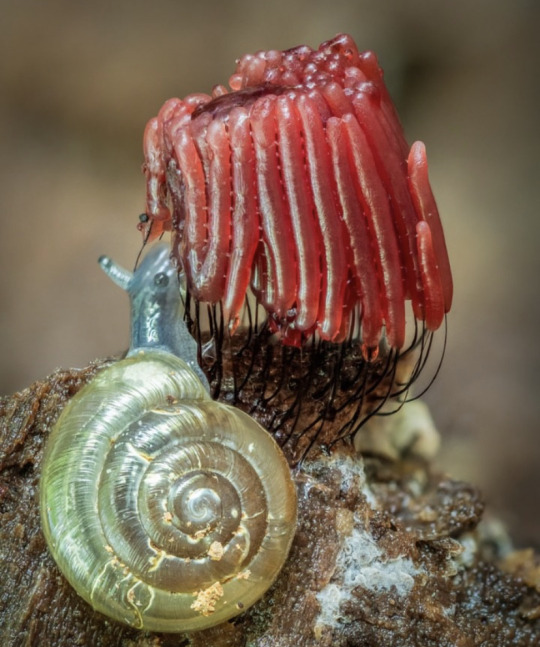
snail eating a Stemonitis slime mold
by Barry Webb
#stemonitis#barry webb#slime mold#myxomycota#snails#molluscs#bugs#slime molds#macro photography#macro world#ecology#biology#nature#microbiology#myxos
4K notes
·
View notes
Text

Drying bonnets
#mushroom#fungi#fungus#mushrooms#artists on tumblr#nature#original photographers#original photography#photography#photographers on tumblr#Washington#pacific northwest#forest#cottagecore#explore#p#slime mold#slime molds#macro#beauty#aesthetic#pnw#westcoastbestcoast#art#vsco#travel#naturecore
512 notes
·
View notes
Text

Jay Lichter Illuminates Stunning Colors and Textures in Macro Photos of Elusive Slime Molds
450 notes
·
View notes
Quote
Slime molds have things to teach us. That a being can change but at the same time remain itselves—to use Octavia Butler’s phrase. That there is life and beauty in rot, in decay, in decomposition, in the ashes. That a hallmark of life is evanescence and ephemerality. That our limited, Romantic understanding of the world—“ew, slime”—is outdated. That nonhierarchical, nonbinary being is part of the reality of the world.
Lucy Jones, Creatures That Don’t Conform
2K notes
·
View notes
Text
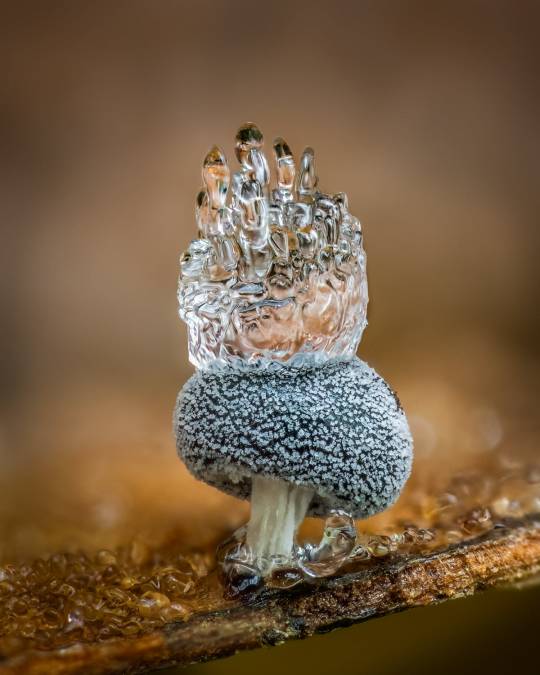
Didymium squamulosum with ice crown.
In Macro Photos, Barry Webb Captures the Fleeting, Otherworldly Characteristics of Slime Molds and Fungi

Metatrichia floriformis and physarum
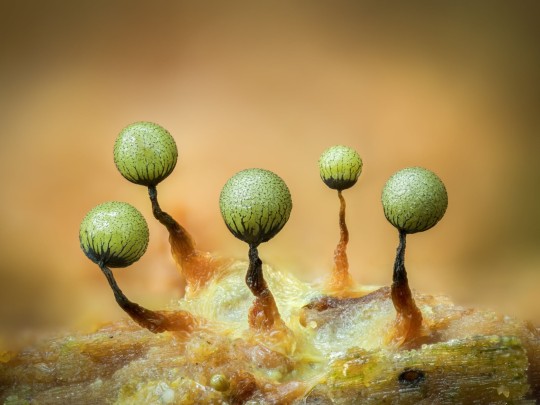
Cribraria

Craterium minutum
#barry webb#photographer#fungus#mushroom#fungi#didymium squamulosum with ice crown#macro photography#slime molds#metatrichia floriformis and physarum#cribraria#craterium minutum
204 notes
·
View notes
Text
I suspect the answer to a lot of life’s mysteries is fungus.
#fungus#mushrooms#avatar#avatar the last airbender#wood wide web#mycelium#hyphae#slime molds#I know they're not a fungus#but still cool#spores
465 notes
·
View notes
Photo
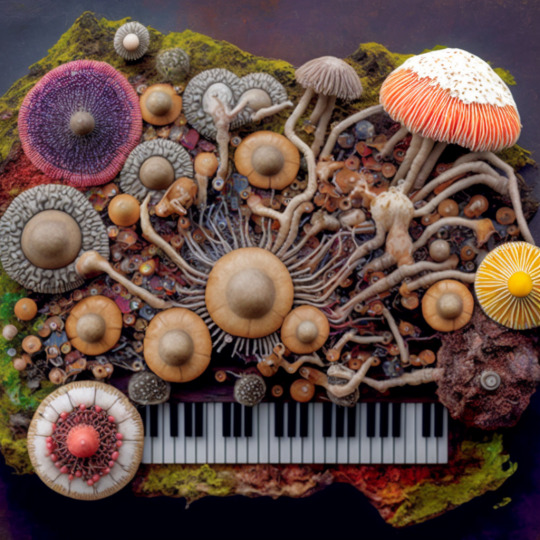

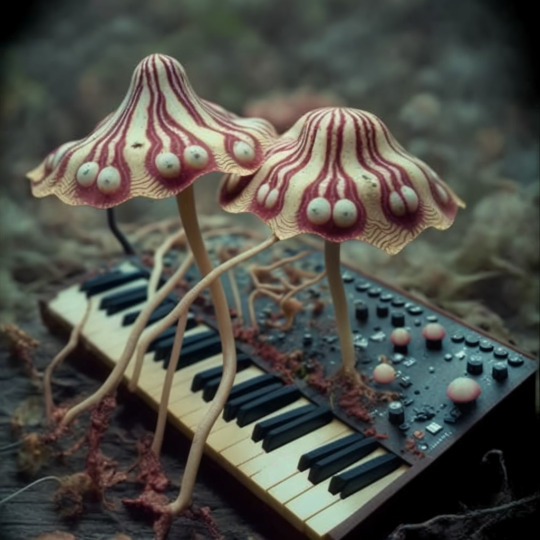
Mycosynthesis
darius greene / ghost owl attic
#mycology#modular synthesis#synth#synths#synthfam#fungi#mycelium#mushroom#mushrooms#shrooms#spores#slime molds#slime mold#electronics#keyboards#music#musical instruments#generative#aiart#growth#electronic music#forest#forest music#nature punk#nature lover#witchy#aesthetic#magic#connections#piano
2K notes
·
View notes
Text


Slime mold growing on the side of a cubby house.
13/01/24 - Lycogala sp.
QLD:WET
88 notes
·
View notes
Text
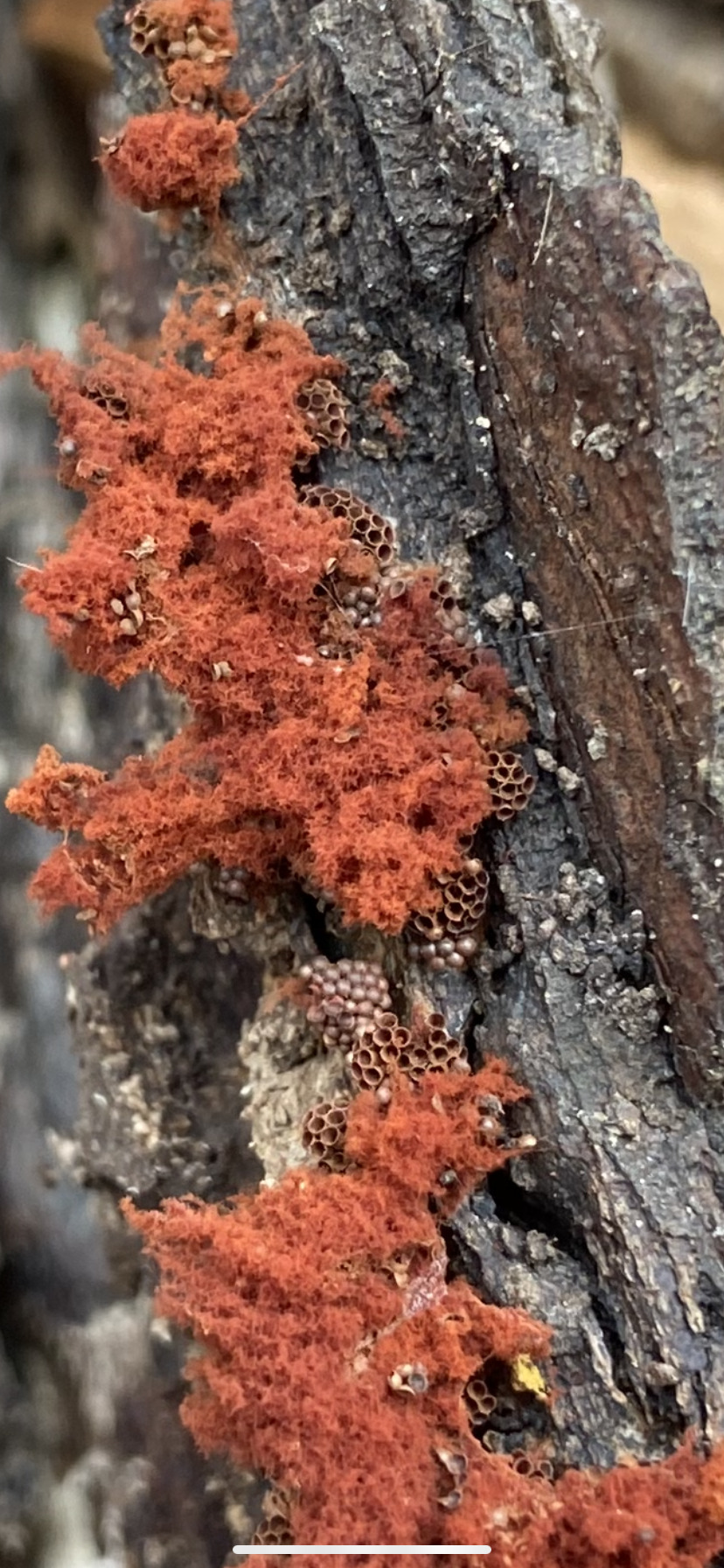

Wasp’s Nest Slime mold
Edit: maybe carnival candy?
87 notes
·
View notes
Text
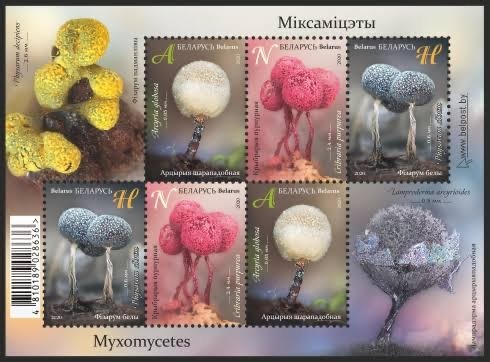
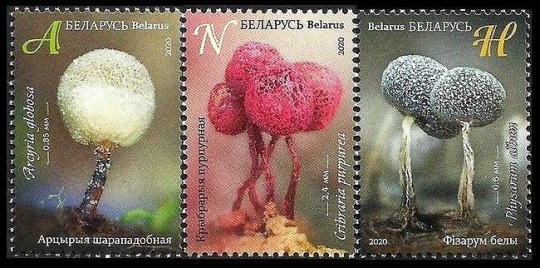

Myxomycetes Stamps, Belarus, 2020.
photos of Arcyria globosa, Cribraria purpurea, Physarum album, Physarum decipiens and Lamproderma arcyrioides by Yevgeniy Moroz.
#sorry i kept fucking this caption up im done now i think 🤦♂️#stamps#myxomycota#slime mold#slime molds#myxomycetes#arcyria globosa#cribraria purpurea#physarum album#physarum decipiens#lamproderma arcyrioides#nature photography#belarus
202 notes
·
View notes
Text

Honeycomb coral slime mold
#slime mold#slime molds#fungi#fungus#macro#forest#nature#beauty#photographers on tumblr#artists on tumblr#original photographers#original photography#photography#aesthetic#Washington#pnw#westcoastbestcoast#art#vsco#pacific northwest#explore#travel#cottagecore#naturecore#grandmacore#p
502 notes
·
View notes
Text

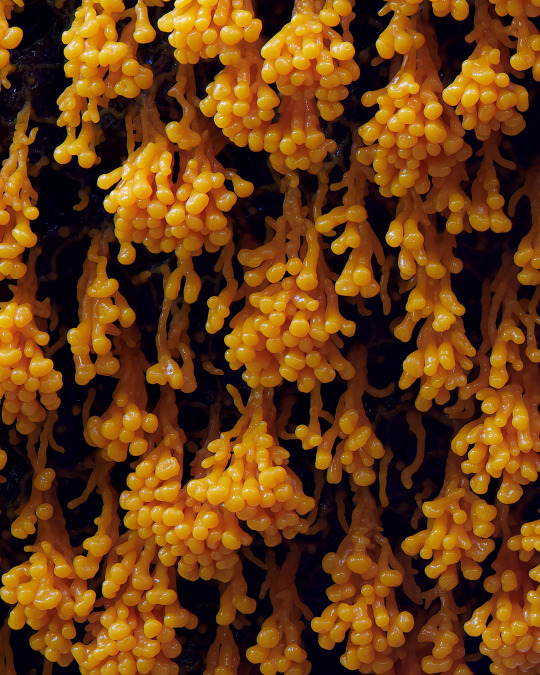
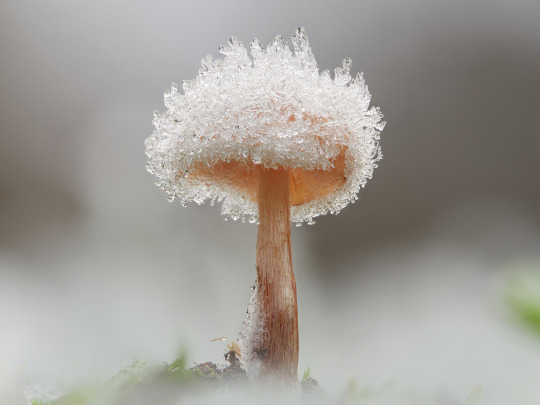
The Astonishing Biodiversity of Fungi Blooms in Max Mudie’s Macro Photographs
5K notes
·
View notes
Link
Slime mold is a common name which is an attempt to describe organisms that defy simple categorization. For a while, it was thought they were fungi, so they were once classed as such (hence, myceto-, meaning fungus). But they are not fungi at all, and they live much of their lives like an animal.
Yes, that’s right: like an animal. Myxomycetes have two main life stages but four in total. First, they exist as amoebae and dwell in high numbers in soil. Then they become a free-moving, hunting, foraging, predating, exploring organism in the plasmodial stage. We know more about this stage because scientists and artists have been able to observe the behavior in laboratory settings, showing that plasmodium can solve various complex problems, such as finding an optimal way home through mazes, or, famously, mapping the car and rail networks of Tokyo more efficiently than humans are able to. We have already learned a lot from slime molds: for example, astronomers have only been able to map the mysterious dark matter that holds the cosmos together with algorithms inspired by plasmodium.
In this creeping stage, slime mold plasmodium is often bright yellow, though it can be orange, red, or hyaline. It can spread for a few inches, or several square meters. Plasmodium feeds on bacteria, fungal hyphae, fruiting bodies, spores, algae, and lichens. Then a radical change occurs and it morphs into fruiting bodies, many of which are brightly colored and distinctive. The fruiting bodies tend to be between one and four millimeters high, visible to the naked eye but much more visible with a hand lens or loupe, I read. Then the slime mold sporulates. Spores carry forth on wind; air currents; in the bodies of others; and in water. The cycle continues.
Describing slime mold in 1868, biologist Thomas Huxley asked: “Is this a plant, or is it an animal? Is it both or is it neither?” Today, we still don’t really know. Myxomycetes are currently placed in the kingdom Protista: Enigmatic creatures that can’t be placed easily in boxes. Creatures that don’t conform. Creatures that defy our understandings of the world. Creatures that spill ooze through constructed human boundaries. Creatures that are at once individual and then collective.
2K notes
·
View notes
Photo
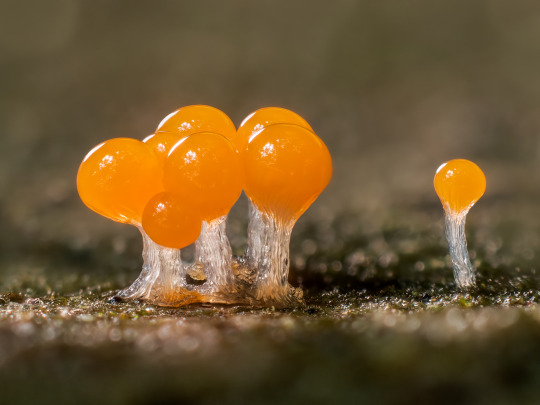
Trichia decipiens
Macro Photos by Barry Webb Highlight the Spectacular Diversity of Slime Molds
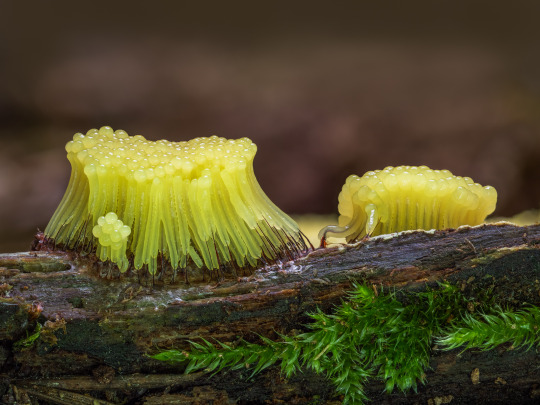
Stemonitis flavogenita

Lamproderma scintillans

Blue Cribraria
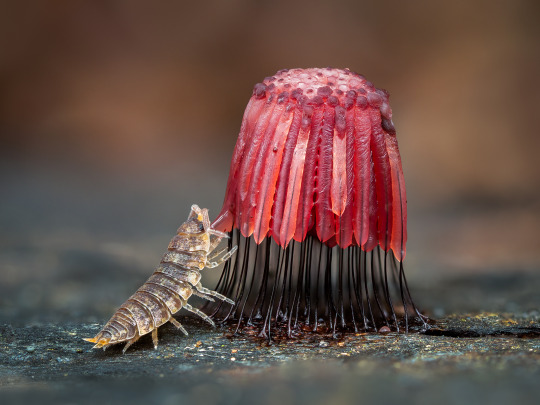
Woodlouse and Stemonitis
#barry webb#photographer#slime molds#molds#trichia decipiens#macro photography#fungi#fungus#nature#stemonitis flavogenita#lamproderma scintillans#blue cribraria#woodlouse#stemonitis
689 notes
·
View notes
Text
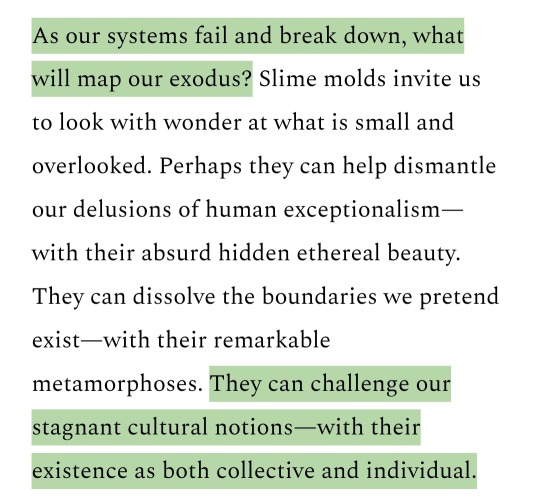
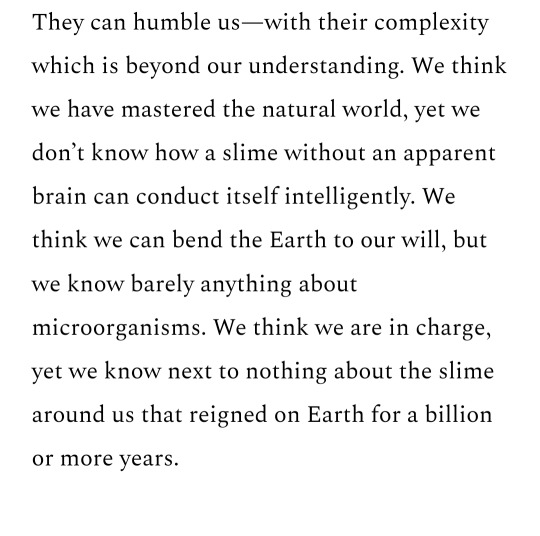
as far as sentences about species extinction & environmental collapse go, "as our systems fail and break down, what will map our exodus?" is fairly unforgettable, thanks
#THE TROUBLE WITH WILDERNESS#spring is the season of resilience#(it's a really lovely slant callback to the fact that slime mold algorithms have helped us map the cosmos)#(lucy jones your mind.)#lucy jones#cc#SLIME MOLDS#ID in alt text#again DO NOT mind me i am just sitting here reading and having THOUGHTS
58 notes
·
View notes